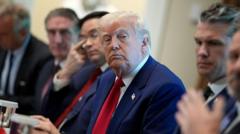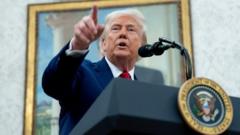The Haskell Free Library and Opera House, a beacon of friendship on the U.S.-Canada border, is now under threat due to shifting political landscapes. Once a symbol of unity, it faces scrutiny as growing tensions between leaders prompt restrictions on access for Canadians.
Borderland Library Faces New Restrictions Amid Rising Tensions

Borderland Library Faces New Restrictions Amid Rising Tensions
Amidst increasing political tensions, the historic Haskell Free Library and Opera House stands at the heart of a cultural crisis affecting U.S.-Canada relations.
The legacy of a wealthy widow who created the library to sit directly on the border is now being tested by geopolitical challenges, as new policies threaten the intimate bonds nurtured by both American and Canadian communities.
Once upon a time, a wealthy widow, who held citizenship in both Canada and the U.S., saw her dream take shape—a grand library and opera house that became a physical manifestation of camaraderie between the two nations. The building, which uniquely straddles the international border, was designed to embrace both countries, symbolized by black tape running across the floor that divides yet unites.
However, this dream is now at risk as U.S. political leaders, emboldened by unilateral policies, threaten to blur the borders further. Recently, the chilling remark of an emissary referencing the potential annexation of Canada has sparked alarm among the Canadian populace, reshaping their perception of their neighbor to the south.
The Haskell Free Library, founded in 1904 by Martha Stewart Haskell, was envisioned as a space accessible to all who shared in its cultural offerings. With escalating tariffs and divisive rhetoric, the heart of this cross-border community is experiencing existential turmoil.
The village of Derby Line, where the library resides, reflects this turmoil as amicable interactions between Canadians and Americans begin to dwindle. The looming potential for heightened restrictions threatens the very essence of cross-border friendships and the local way of life, marking a sharp contrast to a time when such relationships flourished.
As local leaders grapple with the shifting tide, the future of the Haskell Free Library and Opera House hangs in the balance, urging both nations to reconsider the path forward. Will this historical landmark continue to symbolize binational friendship, or will it succumb to the challenges of nationalistic politics? The narrative continues to unfold, as communities await clarity on their intertwined destinies.
Once upon a time, a wealthy widow, who held citizenship in both Canada and the U.S., saw her dream take shape—a grand library and opera house that became a physical manifestation of camaraderie between the two nations. The building, which uniquely straddles the international border, was designed to embrace both countries, symbolized by black tape running across the floor that divides yet unites.
However, this dream is now at risk as U.S. political leaders, emboldened by unilateral policies, threaten to blur the borders further. Recently, the chilling remark of an emissary referencing the potential annexation of Canada has sparked alarm among the Canadian populace, reshaping their perception of their neighbor to the south.
The Haskell Free Library, founded in 1904 by Martha Stewart Haskell, was envisioned as a space accessible to all who shared in its cultural offerings. With escalating tariffs and divisive rhetoric, the heart of this cross-border community is experiencing existential turmoil.
The village of Derby Line, where the library resides, reflects this turmoil as amicable interactions between Canadians and Americans begin to dwindle. The looming potential for heightened restrictions threatens the very essence of cross-border friendships and the local way of life, marking a sharp contrast to a time when such relationships flourished.
As local leaders grapple with the shifting tide, the future of the Haskell Free Library and Opera House hangs in the balance, urging both nations to reconsider the path forward. Will this historical landmark continue to symbolize binational friendship, or will it succumb to the challenges of nationalistic politics? The narrative continues to unfold, as communities await clarity on their intertwined destinies.






















